I still remember the first time I stepped onto this wide, natural stretch and felt time slow down. The warm sand beneath my feet and the soft hush of waves made me want to stay all afternoon.
I write this guide because I fell for the calm here and I want you to feel that same ease. I’ll tell you how to get here, what the shoreline looks like, and when the light is best for long swims and quiet hours.
Expect a truly low-key spot: minimal facilities, light crowds, and a natural vibe that suits visitors who prefer peace over crowds. I also share easy day plans with stops for food, viewpoints, and short detours to enrich your trip.
Throughout this piece you’ll find practical tips on what to pack and where to refuel. By the end, you’ll know whether this stretch of shore fits your plans and how to protect the quiet that makes it special.
Key Takeaways
- I fell for the calm and natural charm of this coastal spot.
- This guide covers access, sights, timing, and simple day plans.
- Expect minimal facilities and a peaceful vibe for relaxed visitors.
- Find practical packing tips and nearby refuel options.
- Short detours add viewpoints and culture to a beach day.
Megas Horos beach in Corfu: What I Love, Where It Is, and Why It’s Still Unspoiled
On my first visit I found a simple coastline that felt untouched and deeply restorative. The spot offers quiet and a true sense of escape on a busy island.
Finding the place
I point you to the south side, past the village of Kritika, roughly 41 km from Corfu Town. Plan for a longer drive so you have time and fuel for the return trip.
What to expect on arrival
You’ll step onto warm sand and face open sea. The waters are clear and calm, and there are no tourist structures—just space to relax.

How it got its name
Two stories give the name life: one tells of pirates who danced here after raids, the other recalls Perivoli’s carnival fires and dances along the shore. Both tie the sand to local festivals and memory.
Best times to visit
Summer has a gentle buzz but stays peaceful; fall brings warm light and far fewer people. Don’t miss the sunset—the colors over the waters are unforgettable.
Respecting the place
Leave no trace. Pack shade, water, and snacks, and take everything with you so visitors after you can enjoy the same tranquility.
| Season | What to Bring | Why Choose It |
|---|---|---|
| Summer | Sunscreen, water, umbrella | Warm waters, relaxed atmosphere |
| Fall | Light jacket, camera, snacks | Fewer people, golden light for sunset |
| Anytime | Trash bag, reusable bottle, respect | Protect the coastline and island traditions |
How I Make a Day of It: Swimming, Sunsets, and Nearby Village Life
I arrange my visits so the hours move gently: swim, rest, eat, and then chase one great view.
Swim and unwind
I start with long swims in calm waters and let the soft sand keep my feet grounded. The sea is shallow near shore, so I take my time and relax.
Food and tavernas
For lunch I drive to a nearby village and pick a laid-back taverna. I order fresh fish, Greek salad, and grilled favorites—food tastes better after the water.
Local color
Lefkimmi and Perivoli bring plenty of life with low-key festivals and music on weekend nights. I enjoy simple customs, and I often catch local songs in a small square.

Chasing views and nature detours
I sometimes stay for the beach’s soft light or drive to Kaiser’s Observatory above Pelekas for a panoramic sunset.
Another great stop is Lakones for the best look over Paleokastritsa Bay. For a nature break, Nymfes Waterfalls are worth the trip—less water in summer, lively again in spring and fall.
My pacing tips:
- Swim early when the waters are calm.
- Lunch at a village taverna to rest and refuel.
- Chase one big view at golden hour, then finish with a quiet stroll.
| Activity | Where | Why |
|---|---|---|
| Morning swim | Shoreline | Gentle waters and soft sand set a calm tone |
| Lunch | Nearby village tavernas | Fresh food and relaxed service after the sea |
| Sunset view | Kaiser’s Observatory or Lakones | Wide panoramas and golden light over the island |
| Nature detour | Nymfes Waterfalls | Best in spring and fall; quieter in summer |
Practical Tips: Getting There, What to Bring, and Staying Safe by the Sea
A short checklist keeps my time on the sand focused on rest, not logistics. I drive the straightforward coastal road on the island’s south side and plan time for fuel and snacks.
Access by road or boat: You can easily reach the coastline by car, and approaching by boat is a calm, fun option when the waters are gentle. If you come by boat, mind local mooring etiquette to protect the seabed and other craft.
Parking basics: Arrive early to pick a good spot near the path. Even quieter stretches fill on warm days, so an early start makes parking easier and keeps your walk light.

What I pack: a reliable sunshade, extra water, reef-friendly sunscreen, a light cooler, a large towel that keeps sand off, hat, sunglasses, and a dry bag for phone and keys. I also bring a small first-aid kit.
Swimming and safety: Read the sea before entering. Avoid rocky patches, watch wind and swell, and stay within your depth. For families and new swimmers, pick a meet-up point and keep an eye on children at all times.
“Verify fuel and cash before you head south; small details matter.”
In fall the sun is softer but evenings cool quickly. Bring layers and keep hydrated if you linger past sunset. From my editor’s perspective, check fuel and local cash, and, in case of a boat trip, confirm mooring rules to protect the place we all love.
Conclusion
This place keeps things simple: the sea feels inviting, the setting stays natural, and a day here unfolds easily.
I follow a plan that works: a morning swim, a bite at a nearby village, one great viewpoint, then a slow drive back across the island.
Small traditions and local festivals lend color to visits and give meaning beyond sun and sand.
Fall is a dream: softer light, warm water, and quieter paths let you breathe and roam with space.
Editor’s note: bookmark this guide, travel with respect, and carry out your trash so the beaches remain wild and welcoming.
FAQ
Where is Megas Horos beach located and how do I get there?
It sits on the southern side of the island, just past the village of Kritika and roughly 41 km from Corfu Town. I usually drive the coastal roads and park nearby; some travelers prefer a short boat ride from local harbors for a quieter arrival. Public buses run toward Lefkimmi, and from there taxis or rented scooters make the final stretch easy.
What should I expect when I arrive?
Expect a sandy coastline with clear, gentle waters and a sense of solitude. There are few tourist structures here, so I bring my own shade, water, and snacks. The vibe is slow and natural, perfect for reading, swimming, or simply watching the sea change color at sunset.
Why is the place called that and what’s the local history?
The name links to old island stories—pirate dances after raids and carnival fires celebrated in nearby Perivoli and Lefkimmi. I find those traditions still echo in local customs and festival music, giving the area a layered cultural feel beyond the shoreline.
When is the best time to visit for weather and crowds?
Summer brings the liveliest atmosphere and warm sea temperatures, while fall gives peaceful days and dramatic sunsets. I go in late spring or early autumn when the water is still pleasant and the crowds thin, so I get the best mix of warmth and tranquility.
Are there facilities, tavernas, or places to eat nearby?
There are no big beach complexes on site, but nearby villages offer authentic tavernas serving fresh seafood and classic island flavors. I drive a few minutes to Lefkimmi or Perivoli for meals, where local recipes and welcoming service feel like part of the outing.
What activities can I plan for a full day?
I swim in the calm waters, relax on the soft sand, and time my visit for sunset. For variety, I pair the day with visits to nearby spots like Pelekas for panoramic views or Paleokastritsa for dramatic bays. Waterfalls at Nymfes make a nice nature detour, especially in spring or autumn when flows are stronger.
Is the area family-friendly and suitable for swimmers?
Yes—gentle shallows make it good for kids and casual swimmers. I still recommend keeping an eye on little ones and using sun protection. There are no lifeguards, so basic caution and common-sense water safety are important.
What should I bring for a comfortable visit?
Bring sunscreen, plenty of water, a hat, and a portable umbrella or shade if you want protection from midday sun. I also pack lightweight footwear for rocky patches, a small cooler for snacks, and a bag to carry out all trash—this place stays beautiful when visitors respect it.
Can I visit by boat and is there anchoring available?
Yes, arriving by boat is a lovely option and keeps the shoreline quiet. I anchor a short distance offshore and use a dinghy to reach the sand. Local captains know the best spots and parking regulations, so checking with them helps avoid hazards and preserves the coast.
How can I help preserve the area while visiting?
I follow a leave-no-trace approach: take all trash with me, avoid disturbing wildlife, and respect local customs and private property. Supporting village tavernas and seasonal festivals also helps the community keep the area vibrant and protected.





